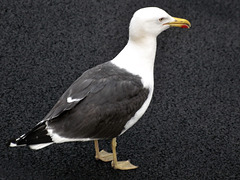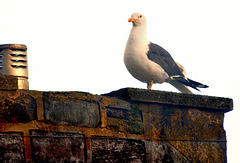Phil's photos with the keyword: Seagull
Seagull in flight (2)
| 24 Jul 2019 |
|
|
|
The European herring gull (Larus argentatus) is a large gull up to 26 inches (66 cm) long. One of the best known of all gulls along the shores of Western Europe, it was once abundant. It breeds across Northern Europe, Western Europe, Central Europe, Eastern Europe, Scandinavia and the Baltic states. Some European herring gulls, especially those resident in colder areas, migrate further south in winter, but many are permanent residents, e.g. in Ireland, Britain, Iceland, or on the North Sea shores. European herring gulls have a varied diet including fish, crustaceans and dead animals as well as some plants. While herring gull numbers appear to have been harmed in recent years, possibly by fish population declines and competition, they have proved able to survive in human-adapted areas and can often be seen in towns acting as scavengers.
(Wikipedia).
Camera: Nikon D500
Lens: AF-S Nikkor 70-200mm f/2.8G ED VR II
Software: Nikon Capture NX2
Seagull in flight.
| 20 Jul 2019 |
|
|
|
The European herring gull (Larus argentatus) is a large gull up to 26 inches (66 cm) long. One of the best known of all gulls along the shores of Western Europe, it was once abundant. It breeds across Northern Europe, Western Europe, Central Europe, Eastern Europe, Scandinavia and the Baltic states. Some European herring gulls, especially those resident in colder areas, migrate further south in winter, but many are permanent residents, e.g. in Ireland, Britain, Iceland, or on the North Sea shores. European herring gulls have a varied diet including fish, crustaceans and dead animals as well as some plants. While herring gull numbers appear to have been harmed in recent years, possibly by fish population declines and competition, they have proved able to survive in human-adapted areas and can often be seen in towns acting as scavengers.
(Wikipedia).
Camera: Nikon D500
Lens: AF-S Nikkor 70-200mm f/2.8G ED VR II
Software: Nikon Capture NX2
Lesser Black-Backed Gull.
| 08 Aug 2018 |
|
|
|
The lesser black-backed gull was described by Linnaeus in his 18th-century work, Systema Naturae and it still bears its original name of Larus fuscus. The scientific name is from Latin. Larus appears to have referred to a gull or other large seabird and fuscus meant black or brown.
A confusable species is the great black-backed gull. The lesser is a much smaller bird with slimmer build, yellow rather than pinkish legs and smaller white "mirrors" at the wing tips. The adults have black or dark grey wings and back. The bill is yellow with a red spot which the young peck at, inducing feeding.
(Wikipedia. Edited)
Camera: Nikon D300s
Processed with Nikon Capture NX2.
Seagull at sunrise.
| 05 Aug 2017 |
|
|
|
The Great Black Backed Gull (Larus marinus). A very large, thick-set black-backed gull with a powerful beak. Adults are blacker than the smaller Lesser Black-Backed gull. It has a heavy flight and can look quite hunched when perched. It will fight off other gulls and chase them to snatch food. Found around the coasts in the breeding season. At other times of year it can be found wherever gulls congregate - at reservoir roosts, rubbish tips inland and bays and harbours.
(RSPB website).
Camera: Nikon D300s.
Lens: AF-S VR Zoom-Nikkor 70-300mm f/4.5-5.6G IF-ED lens.
Processed with Nikon Capture NX2.
Gull in flight.
| 07 Feb 2014 |
|
|
|
Although we are about 35 miles from the nearest sea, we often get "invaded" by flocks of gulls. This one was photographed in Brierfield, North-West England, using a Nikon D300s fitted with an AF-S Nikkor 70-200mm f/2.8G ED VR II lens in "High Speed" mode and processed with Nikon Capture NX2.
Jump to top
RSS feed- Phil's latest photos with "Seagull" - Photos
- ipernity © 2007-2025
- Help & Contact
|
Club news
|
About ipernity
|
History |
ipernity Club & Prices |
Guide of good conduct
Donate | Group guidelines | Privacy policy | Terms of use | Statutes | In memoria -
Facebook
Twitter





